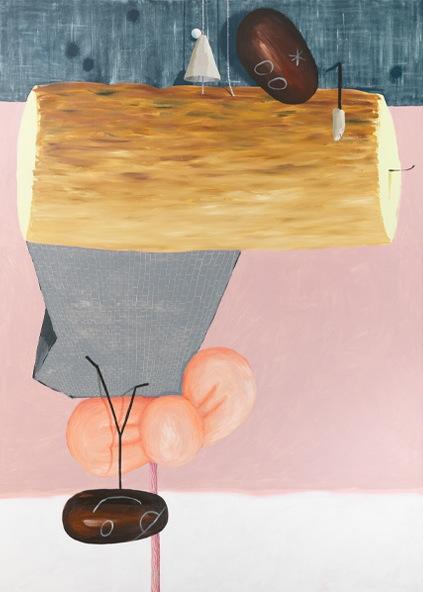Ranging in scale from the intimate to something more formidable, Mason’s paintings are composed around constellations of object-‐like forms set against unreal expansive grounds. Rendered in saccharine tones of pinks, greys and plasticky yellow ochres, these awkward, sometimes cumbersome shapes appear to have been accumulated serially. As if to constitute a stopgap, something defiantly improvised, objects are collected, connected and collated one by one. With each figure affecting the one that went before it, weighing it down, pushing it sideways grudgingly, there is a somewhat sculptural, perhaps even bodily, sense to this evolving progress that eventually organises the picture plane.
Echoing the ethos of bricolage, Mason’s paintings develop not by design but by virtue of a keen eye as to the visual information to hand. This can be anything from studio paraphernalia, passing thoughts, or a fleeting glimpse of something just beyond her high studio window. Borne of a willingness to give over to the internal logic of each painting, this flexibility means that her burgeoning compositions are often incongruous in their juxtapositions, and this to both witty and bathetic affects. ‘The Valour of Our Ancestors’ for example pictures the very top of a flag against a big blue sky. Although bearing the symbols of heraldic imagery its ambitions to billow freely in the wind are made clunky, abruptly clipped by its being made from earthly wood and cardboard. Beneath it we see the tip of a fellow banner and with that flag seems condemned to a life sutured to the ground.
Elsewhere the sense of growth associated with this type of accumulative process is countered by the forced inclusion of its unwanted bi-‐products, which often manifest themselves as some kind of leakage. ‘Cameo’ pictures the forlorn extrusion of a tear-‐like puddle from the bottom of a floating wooden block. ‘Team GB’ on the other hand presents a hording that spans almost the width of the picture. Apathetically a surgical mask has been tossed over it. Emblazoned, once proudly perhaps, with the Union Jack, the abandoned mask might make a wry allusion to the Olympic ideals of community and inclusion. Furthermore, into the side of the hoarding a pipe-‐like outlet is roughly jammed. It seems that although our vision of what lies behind the fence is obscured, the existence of a less-‐than-‐desirable excess is regarded as an occurrence that is inevitable anyway, in any circumstance, and is duly accounted for without too much resistance. Manifested in forms that appear to be slumped or deflated, there is indeed a sense of resignation that runs through the works, a reaching that has been disappointed and forced to shrink back upon encountering its limits.
The title ‘Zeros and Tens’ betrays this economy on which the paintings function. It describes two poles, the extremes of high and low between which everything else takes place: life, exchange, advance and shrinkage. Mason builds her pictures using discrete individual units. They are quantifiable entities of manageable sizes inhabiting the given parameters of the canvas as body. They can be erected, knocked down, arranged and rearranged in an endless play. Perhaps in dealing with definite objects whose totality can be grasped, she is cultivating a space for herself that enables creative activity to persist against the threat of being overwhelmed. But her paintings also offer something else. Sometimes glimpsed in unpainted exit-‐like patches, it seems that there at the very moment of failure, or indeed of finally letting go, something else begins to open, something more promising.
Jill Mason (born Leeds, UK, 1974 – lives and works in London) studied at Winchester School of Art before graduating from the Royal Academy Schools in 2008. Her work has been featured in several high-‐profile group exhibitions, such as the Jerwood Contemporary Painters (London, 2010), Code of Being (Beijing, 2009) and Objects In The Forest (London, 2009) and is held in the Saatchi collection.
Text by Gili Tal, London 2012

